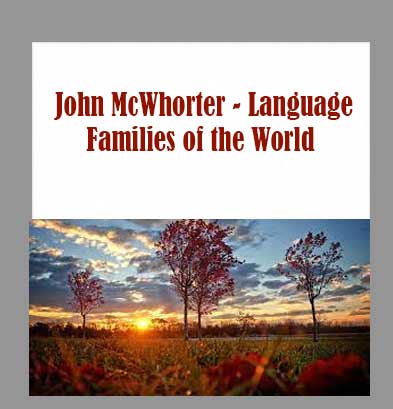
Description
John McWhorter – Language Families of the World download, John McWhorter – Language Families of the World review, John McWhorter – Language Families of the World free
John McWhorter – Language Families of the World
Language Families of the World
Using the tools of linguistics, undertake a voyage of discovery to uncover the origins of language families around the world and the ways languages have developed and changed over time.
LECTURE (34)
01:Why Are There So Many Languages?
There are over 7,000 languages in the world and many linguists believe they likely all developed from a single source language in the distant past. Get an introduction to the concept of language families, understand how languages change over time, and discover what linguistics can teach us about our own history.
02:The First Family Discovered: Indo-European
While the Indo-European family of languages was not the first group to be identified as related, it is the family that has received much of the research and classification that became the basis of modern linguistics. Uncover what defines Indo-European languages, which include Latin, English, French, Armenian, Latvian, Sanskrit, and many more.
03:Indo-European Languages in Europe
Begin a deep dive into the earliest roots of Indo-European languages with a look at Germanic, Romance, Balto-Slavic, Greek, Albanian, and Celtic languages. See how Indo-European languages contradict common notions about how language works and uncover some of the mysteries that are yet to be solved.
04:Indo-European Languages in Asia
One-fifth to one-sixth of the world speaks one of the Indo-European languages of India. Trace back to the branching of the Indo-European tree, when the European languages split from the Indo-Aryan varieties like Sanskrit that would become Hindi and others. Explore many variations that evolved and see why it can be so difficult to differentiate between a language and a dialect.
05:The Click Languages
Shift from Indo-European to some of the most endangered languages in the world: the “click” languages, formally known as Khoisan. Spoken in southern Africa, these endangered languages share a distinctive profile, and yet likely did not all come from a single family. Explore where they may have begun and how they work.
06:Niger-Congo: Largest Family in Africa I
The Niger-Congo family consists of anywhere from 1,000 to 1,500 different languages. While they are part of the same family, they do not adhere to an identified pattern like Indo-European. What links this immense family together? What is the essence of the Niger-Congo? What can these languages tell us about migration patterns? Explore these questions and more.
07:Niger-Congo: Largest Family in Africa II
Look closer at some of the unique aspects of the Niger-Congo family, including the use of tone, and see how different languages can spring from the same original materials. Since the work of classifying languages is on-going, you may be surprised to see how many can develop in proximity and share words but be part of different groups altogether.
08:Languages of the Fertile Crescent and Beyond I
Follow the migration of peoples from Africa to the Middle East by looking at the language family that developed in the Fertile Crescent: Afro-Asiatic. This first look at this family focuses on the widely known Semitic branch, which includes Arabic and Hebrew. Examine what defines this group of languages and uncover the roots of the first alphabets.
09:Languages of the Fertile Crescent and Beyond II
Move beyond the Semitic languages to look at other subfamilies of Afro-Asiatic, including what some call the “Berber” subfamily and several other subfamilies spoken south of the Sahara, and see what they can teach us about the nature of language. Close with a look at Somali oral poetry and its complex use of alliteration.
10:Nilo-Saharan: Africa’s Hardest Languages?
Afro-Asiatic languages are prevalent in the north of the African continent, and Niger-Congo in the south, with a narrow band of a third family running between: Nilo-Saharan. The Nilo-Saharan languages are immensely different from each other, so how do linguists know they are related? Examine the unique features of this family.
11:Is the Indo-European Family Alone in Europe?
Meet the other family of languages in Europe: Uralic, which includes Estonian, Finnish, and Hungarian. Eccentric and tidy at the same time, this family stretches across the north of Europe and into Russia and parts of Asia. See why Turkish was once thought to be part of this family and how Uralic languages differ from Indo-European and others.
12:How to Identify a Language Family
How do linguists establish connections between languages and determine their common roots when it is nearly impossible to see a language change in real time? Take a look at the languages of Polynesia to see how changes can be followed backwards to reveal connections between different languages, then turn to the Indo-European and Uralic families.
13:What Is a Caucasian Language?
Named for the Caucasus mountains where they originate, the Caucasian languages are actually three different families: Northwestern, Northeastern, and a Southern one that includes Georgian. Explore these grammatically complex languages to better understand how they work and how so many different varieties can spring from a relatively small area.
14:Indian Languages That Aren’t Indo-European
The “Big Four” languages (and many others) of southern India are not part of the Indo-European family but rather the Dravidian. Look at what the distribution of Dravidian languages says about where they come from and how they got where they are now—including some languages on the brink of extinction—and explore some of their unique features.
15:Languages of the Silk Road and Beyond
The languages called Altaic are spoken across Asia, from Turkey through Mongolia and to northeastern regions of Asia. Understand why there is some debate among linguists as to whether they comprise one family or are made of three separate ones as you look at how these languages function, including nuances like a mood known as “evidentiality.”
16:Japanese and Korean: Alike yet Unrelated
Are Japanese and Korean part of the Altaic family? They share some features of the other Altaic languages, yet some linguists believe they are separate. Take a brief foray through the fascinating Japanese writing system as you look deeper into the language. Then, turn to Korean, comparing and contrasting it with Japanese and other Asian languages.
17:The Languages We Call Chinese
Explore the Asian languages beyond Japanese and Korean, looking into several families along the way. See why Mandarin and Cantonese, though both considered Chinese, are a classic example of two different languages being mistaken for dialects—thanks in part to a shared writing system and cultural proximity.
18:Chinese’s Family Circle: Sino-Tibetan
Chinese is one branch of the Sino-Tibetan family and the other branch, Tibeto-Burman, consists of around 400 languages spoken in southern China, northeastern India, and Burma. Look at features of languages from both branches and see what linguists can assume about the proto-language from which they may have sprung.
19:Southeast Asian Languages: The Sinosphere
How can languages that have very different origins still seem to be structurally related? To find out, look at the concept of a Sprachbrund and understand why contact is just as influential as origin when it comes to resemblances between otherwise unrelated languages—in this case, the influence of Chinese on other Asian languages.
20:Languages of the South Seas I
Journey to the South Seas to begin an investigation into Austronesian, one of the world’s largest and most widespread language families. See what connects Austronesian languages to other families, as well as how they differ from European languages, and trace the way Austronesian languages have spread across far-flung locations.
21:Languages of the South Seas II
The languages of Polynesia are estimated to be some of the newest languages in the world, emerging only in the last millenium. Look back to the earliest cultures of the Polynesian islands to see how the languages likely originated and were disseminated, branching into separate sub-groups like Oceanic and the three that are all spoken on the small island of Formosa.
22:Siberia and Beyond: Language Isolates
How do some languages end up isolated amidst other, unrelated families? Look at pockets of language in Siberia, Spain, and Japan that are not related to those that surround them and better understand what the nature of language—and human migration and settlement patterns—can tell us about these unique places.
23:Creole Languages
Since all languages come from one original language, technically no one language is older than another. However, when two languages are forced into proximity, often a makeshift fusion of the two can emerge as a new language, known as a creole. Learn how a hierarchical, stopgap form of communication can become a true language.
24:Why Are There So Many Languages in New Guinea?
Turn your attention to one of the most linguistically rich places on Earth: the island of New Guinea, and discover why, thanks to its history and isolating terrain, it is home to hundreds of languages in a relatively small area. See how pronouns allow linguists to find connections between these languages, and explore some of their unusual traits.
25:The Languages of Australia I
Once the home of over 250 languages, Australia now only has about a dozen languages that will be passed to sizable generations of children. Take a look at some of the over two dozen language families in Australia and better understand how both separation from a common ancestor and proximity to a different language will cause a language to change in different ways.
26:The Languages of Australia II
Continue your examination of the languages of Australia, including the first Australian language to be documented by Europeans. Many of these languages present a case study in language obsolescence (as English dominates the continent) and language mixture (the emergence of creole languages due to European contact).
27:The Original American Languages I
Like Australia, North America was home to at least 300 distinct languages before English became dominant. Professor McWhorter takes you through some of the theories linguists have regarding the relationship of various Native American languages and the origins of humans and their varieties of speech on the North American continent.
28:The Original American Languages II
Zoom in on some of the larger families of North America and gain valuable insight into what they can tell us about language in general. You will get the chance to examine languages that are on the brink of extinction today, see which languages have contributed words currently used in American English, and more.
29:The Original American Languages III
Continue your journey through the languages of North America, including a language that uses no sounds that require the lips to touch. As you look at the unique grammatical features of languages across the continent, you will also consider what happens when languages die out and their complexities are lost to future generations.
30:The Original American Languages IV
Follow Native American migrations to encounter the language families that moved south to take root in Central and South America. From a language variety that incorporates whistling to some with object-subject-verb word order—and even one that resulted from a mass kidnapping—you will experience a range of fascinating linguistic developments.
31:Languages Caught between Families
The line between different language families is often blurred. Languages from different families that have been brought together can create a hybrid that belongs to both, and every combination happens in different ways and to varying degrees. Look at several examples of this phenomenon (which even includes English).
32:How Far Back Can We Trace Languages?
Embark on a quest that some believe may be impossible: tracing the relationships between the macro language families. See how the pursuit of evidence connecting the language families is complicated by time, accidental similarities, lost languages, and more, as you also look at several plausible theories that could offer solutions.
33:What Do Genes Say about Language Families?
The idiosyncrasies that show up in DNA allow us to trace back to common ancestors, much like language traits allow us to chart language-family relationships. Take a look at the concept of glottochronology and see what linguistic theories have been confirmed by genetics in places like Europe, India, and Polynesia—as well as some surprises.
34:Language Families and Writing Systems
What do writing systems tell us about language? Better understand why writing actually tells us more about human ingenuity in communication than it tells us about spoken language. Close with a consideration of the cultural importance of language, its preservation and loss, and the realities of a more linguistically homogeneous future.
DETAILS
Overview
In Language Families of the World, Professor John McWhorter takes you back through time and around the world, following the linguistic trails left by generations of humans that lead back to the beginnings of language. Utilizing historical theories and cutting-edge research, these 34 astonishing lectures will introduce you to the major language families of the world and their many offspring, including a variety of languages that are no longer spoken but provide vital links between past and present.
About
John McWhorter
“Far from being a language in decline, we have reason to believe that English, with all its beauty and quirks and illogicities, will be carried far into the future.”
ALMA MATER Stanford University
INSTITUTION Columbia University
John McWhorter is an Associate Professor of English and Comparative Literature at Columbia University. He earned a PhD in Linguistics from Stanford University. He is the author of several books, including The Power of Babel: A Natural History of Language; Nine Nasty Words: English in the Gutter; and Word on the Street, a book on dialects and Black English. He has also been published in outlets such as The New York Times and The Washington Post, and he has appeared on Dateline and Good Morning America, among other platforms.
Frequently Asked Questions:
- Innovative Business Model:
- Embrace the reality of a genuine business! Our approach involves forming a group buy, where we collectively share the costs among members. Using these funds, we purchase sought-after courses from sale pages and make them accessible to individuals facing financial constraints. Despite potential reservations from the authors, our customers appreciate the affordability and accessibility we provide.
- The Legal Landscape: Yes and No:
- The legality of our operations falls into a gray area. While we lack explicit approval from the course authors for resale, there’s a technicality at play. When procuring the course, the author didn’t specify any restrictions on resale. This legal nuance presents both an opportunity for us and a boon for those seeking budget-friendly access.
- Quality Assurance: Unveiling the Real Deal:
- Delving into the heart of the matter – quality. Acquiring the course directly from the sale page ensures that all documents and materials are identical to those obtained through conventional means. However, our differentiator lies in going beyond personal study; we take an extra step by reselling. It’s important to note that we are not the official course providers, meaning certain premium services aren’t included in our package:
- No coaching calls or scheduled sessions with the author.
- No access to the author’s private Facebook group or web portal.
- No entry to the author’s exclusive membership forum.
- No direct email support from the author or their team.
We operate independently, aiming to bridge the affordability gap without the additional services offered by official course channels. Your understanding of our unique approach is greatly appreciated.
- Delving into the heart of the matter – quality. Acquiring the course directly from the sale page ensures that all documents and materials are identical to those obtained through conventional means. However, our differentiator lies in going beyond personal study; we take an extra step by reselling. It’s important to note that we are not the official course providers, meaning certain premium services aren’t included in our package:
Refund is acceptable:
- Firstly, item is not as explained
- Secondly, Item do not work the way it should.
- Thirdly, and most importantly, support extension can not be used.
Thank you for choosing us! We’re so happy that you feel comfortable enough with us to forward your business here.








Reviews
There are no reviews yet.